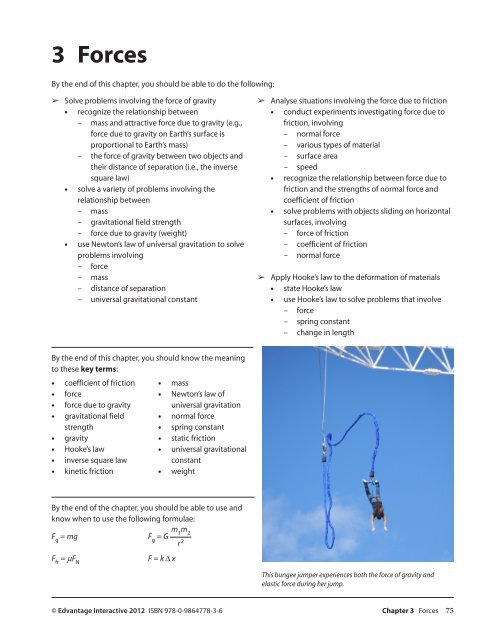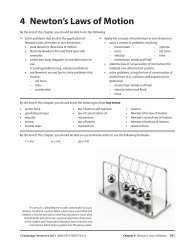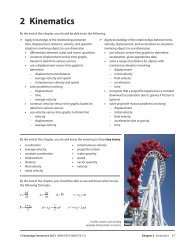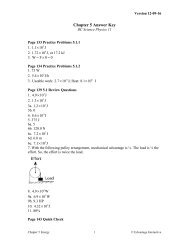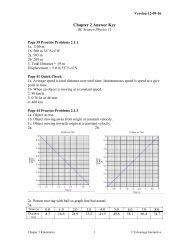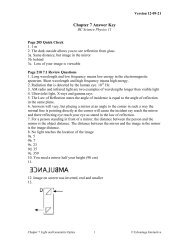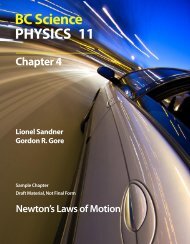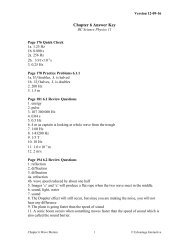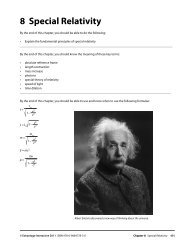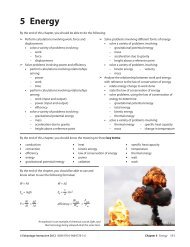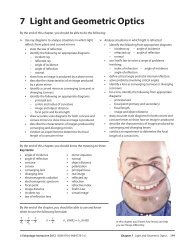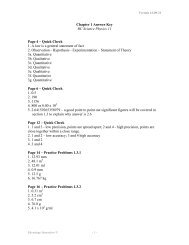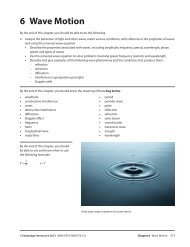3 Forces - BC Science Physics 11
3 Forces - BC Science Physics 11
3 Forces - BC Science Physics 11
You also want an ePaper? Increase the reach of your titles
YUMPU automatically turns print PDFs into web optimized ePapers that Google loves.
3 <strong>Forces</strong><br />
By the end of this chapter, you should be able to do the following:<br />
➢ Solve problems involving the force of gravity<br />
• recognize the relationship between<br />
– mass and attractive force due to gravity (e.g.,<br />
force due to gravity on Earth’s surface is<br />
proportional to Earth’s mass)<br />
– the force of gravity between two objects and<br />
their distance of separation (i.e., the inverse<br />
square law)<br />
• solve a variety of problems involving the<br />
relationship between<br />
– mass<br />
– gravitational field strength<br />
– force due to gravity (weight)<br />
• use Newton’s law of universal gravitation to solve<br />
problems involving<br />
– force<br />
– mass<br />
– distance of separation<br />
– universal gravitational constant<br />
By the end of this chapter, you should know the meaning<br />
to these key terms:<br />
• coefficient of friction<br />
• force<br />
• force due to gravity<br />
• gravitational field<br />
strength<br />
• gravity<br />
• Hooke’s law<br />
• inverse square law<br />
• kinetic friction<br />
• mass<br />
• Newton’s law of<br />
universal gravitation<br />
• normal force<br />
• spring constant<br />
• static friction<br />
• universal gravitational<br />
constant<br />
• weight<br />
By the end of the chapter, you should be able to use and<br />
know when to use the following formulae:<br />
F g = mg F g = G m 1 m 2<br />
r 2<br />
F fr = µF N<br />
F = k ∆ x<br />
➢ Analyse situations involving the force due to friction<br />
• conduct experiments investigating force due to<br />
friction, involving<br />
– normal force<br />
– various types of material<br />
– surface area<br />
– speed<br />
• recognize the relationship between force due to<br />
friction and the strengths of normal force and<br />
coefficient of friction<br />
• solve problems with objects sliding on horizontal<br />
surfaces, involving<br />
– force of friction<br />
– coefficient of friction<br />
– normal force<br />
➢ Apply Hooke’s law to the deformation of materials<br />
• state Hooke’s law<br />
• use Hooke’s law to solve problems that involve<br />
– force<br />
– spring constant<br />
– change in length<br />
This bungee jumper experiences both the force of gravity and<br />
elastic force during her jump.<br />
© Edvantage Interactive 2012 ISBN 978-0-9864778-3-6 Chapter 3 <strong>Forces</strong> 75
3.1 Force of Gravity<br />
Warm Up<br />
Take a sheet of paper and a book in each hand. Hold at shoulder level. If you release them at the same time,<br />
which will hit the ground first? Can you create a rule for falling objects that explains how different masses fall to<br />
Earth?<br />
_____________________________________________________________________________<br />
_____________________________________________________________________________<br />
_____________________________________________________________________________<br />
Force<br />
Gravitational Force<br />
Every time you push, pull, twist or squeeze something you exert a force on it. Almost<br />
every time you exert a force on an object, you change something about that object: its<br />
speed, its direction, or its shape. A force is a push or a pull.<br />
When a soccer player “heads” the ball the speed of the ball changes, and sometimes<br />
its direction does too. When a hockey player is given a solid body check, the force<br />
changes his direction and speed. When a golf ball is struck by a golf club, the force of the<br />
impact changes the ball’s shape during the collision. The force due to air friction alters the<br />
shape of a raindrop, from a perfect sphere to something more like a teardrop.<br />
<strong>Forces</strong> are measured in a unit called the newton (N), named after Sir Isaac Newton.<br />
The force of gravity pulls on you all the time. The force of attraction between planet Earth<br />
and you keeps you from floating aimlessly off into space! Any two bodies in the universe<br />
exert a gravitational force on each other. The amount of force they exert depends upon<br />
how massive the bodies are and how far apart they are. Two unique facts about the force<br />
of gravity are: (1) it cannot be “shut off”; and (2) it is always an attractive force, never<br />
repulsive.<br />
Gravitational force is an example of a force that acts on objects without touching<br />
them. This classifies gravity as an action-at-a-distance force. Gravitational force creates<br />
a gravitational field around a body. Think of a field as an area where a force is exerted.<br />
For example, magnets have a field around them created by the attraction and repulsion<br />
between magnetic poles. A gravitational field depends on the mass of an object. The<br />
bigger the mass, the bigger the gravitational field. For Earth, this means a small mass<br />
like a person is attracted to the centre of Earth because Earth is the larger mass. The<br />
gravitational force experienced by the person results mainly from the Earth’s gravitational<br />
field. The force within the gravitational field is referred to as the gravitational field<br />
strength. It is measured as the gravitational force per unit mass or g = Fg . The symbol for<br />
m<br />
gravitational field strength is g. At Earth’s surface, g is approximately 9.81 N/kg.<br />
76 Chapter 3 <strong>Forces</strong> © Edvantage Interactive 2012 ISBN 978-0-9864778-3-6
Weight<br />
Quick Check<br />
Regardless of where you are on Earth, near the surface, objects will fall with the same<br />
acceleration regardless of their mass. Other forces such as air resistance may slow an<br />
object down, but the acceleration due to gravity remains constant. Gravitational force is<br />
equal to the product of an object’s mass and the acceleration due to gravity.<br />
F g = mg<br />
When we calculate the gravitational force acting on an object, we are calculating its<br />
weight. This is an example of a term that has a specific meaning in science, but has other<br />
everyday uses. Many times people use the term weight to refer to mass. For example,<br />
when someone asks you how much you weigh, they are actually asking you what your<br />
mass is. The difference between weight and mass is that weight in measured in newtons<br />
and mass is measured in metric units such as grams or kilograms.<br />
1. What is the force of gravity on a 90 kg person? What is the weight of this person?<br />
2. If a person experiences a 637 N force of gravity on Earth’s surface, what is the person’s mass?<br />
3. A 75 kg person would experience a force of gravity of 127.5 N on the Moon. What is the gravitational field<br />
strength on the Moon?<br />
Measuring the Force<br />
of Gravity<br />
Gravity causes unsupported objects to fall toward Earth. The usual way to measure the<br />
force of gravity is to balance it with another force acting upward. For example, when you<br />
stand on a bathroom scale, gravity pulls you downward. A coiled spring inside the scale<br />
pushes upward and balances the force of gravity.<br />
© Edvantage Interactive 2012 ISBN 978-0-9864778-3-6 Chapter 3 <strong>Forces</strong> 77
Newton’s Law<br />
of Universal<br />
Gravitation<br />
The common laboratory spring balance uses a spring that is stretched by the force<br />
of gravity acting on the object that is being “weighed” (Figure 3.1.1). If the spring is of<br />
good quality, the amount it stretches will depend directly on the force of gravity. That is,<br />
if the force of gravity doubles, the stretch will double. If the force of gravity triples, the<br />
stretch will triple. In other words, the amount of stretch is directly proportional to the<br />
force of gravity on the object.<br />
(a) (b)<br />
Figure 3.1.1 An example of a laboratory spring balance showing the gauge (a)<br />
and the spring (b)<br />
One of Sir Isaac Newton’s many valuable contributions to science is his law of universal<br />
gravitation. Newton (1642–1727) realized that the force of gravity, which affects you<br />
and everything around you, is a universal force. Any two masses in the universe exert a<br />
gravitational force on each other. The force that keeps planets in orbit is the same force<br />
that makes an apple fall to the ground. How strong the force is depends on how massive<br />
the bodies are. It also depends on the distance between the two bodies.<br />
Like all other forces, gravity is a mutual force. That is, the force with which the Earth<br />
pulls on a falling apple is equal to the force with which the apple pulls on the Earth, but<br />
in the opposite direction. The Earth pulls on your body with a force of gravity that is<br />
commonly referred to as your “weight.” Simultaneously, your body exerts a force on planet<br />
Earth of the same magnitude but in the opposite direction.<br />
Newton was able to use Kepler’s laws of planetary motion as a starting point for<br />
developing his own ideas about gravity. Johannes Kepler (1571–1630) was a German<br />
astronomer who described the motion of the planets around the Sun now called Kepler’s<br />
Laws. You will study these laws in future courses. Using Kepler’s laws, Newton showed<br />
that the force of gravity between the Sun and the planets varied as the inverse of the<br />
square of the distance between the Sun and the planets. He was convinced that the<br />
inverse square relation would apply to everyday objects near Earth’s surface as well. He<br />
produced arguments suggesting that the force would depend on the product of the<br />
masses of the two bodies attracted to one another. The result was his law of universal<br />
gravitation.<br />
78 Chapter 3 <strong>Forces</strong> © Edvantage Interactive 2012 ISBN 978-0-9864778-3-6
Cavendish’s<br />
Experiment to<br />
Measure G<br />
Newton’s law of universal gravitation can be summarized as follows:<br />
Every body in the universe attracts every other body with a force that (a) is directly<br />
proportional to the product of the masses of the two bodies, and (b) is inversely<br />
proportional to the square of the distance between the centres of mass of the two<br />
bodies.<br />
The equation for Newton’s law of universal gravitation is:<br />
F g = G<br />
© Edvantage Interactive 2012 ISBN 978-0-9864778-3-6 Chapter 3 <strong>Forces</strong> 79<br />
m 1 m 2<br />
r 2<br />
where G is the universal gravitation constant, m 1 and m 2 are the masses of the bodies<br />
attracting each other, and r is the distance between the centres of the two bodies.<br />
Isaac Newton was unable to measure G, but Henry Cavendish (1731–1810)<br />
measured it later in experiments. The modern value for G is 6.67 × 10 –<strong>11</strong> N•m 2 /kg 2 .<br />
You can imagine how difficult it is to measure the gravitational force between two<br />
ordinary objects. In 1797, Henry Cavendish performed a very sensitive experiment that<br />
was the first Earth-bound confirmation of the law of universal gravitation. Cavendish<br />
used two lead spheres mounted at the ends of a rod 2.0 m long. The rod was suspended<br />
horizontally from a wire that would twist an amount proportional to the gravitational<br />
force between the suspended masses and two larger fixed spherical masses placed near<br />
each of the suspended spheres. (See Figure 3.1.2.)<br />
� �<br />
� �<br />
Figure 3.1.2 Cavendish’s apparatus<br />
The forces involved in this experiment were extremely small (of the order 10 –6 N),<br />
so great care had to be taken to eliminate errors due to air currents and static electricity.<br />
Cavendish did manage to provide confirmation of the law of universal gravitation, and he<br />
arrived at the first measured value of G.<br />
� �<br />
� �
Earth’s Gravitational<br />
Field Strength<br />
Quick Check<br />
To calculate the force of gravity on a mass m, you could simply multiply the mass by the<br />
gravitational field strength, g (F = mg). You could also use the law of universal gravitation:<br />
Mm<br />
Fg = G<br />
r2 , where M is the mass of Earth.<br />
This means that mg = G Mm<br />
r2 , and therefore,<br />
g = G M<br />
r 2<br />
Thus, the gravitational field strength of Earth depends only on the mass of Earth<br />
and the distance, r, from the centre of Earth to the centre of mass of the object that has<br />
mass m.<br />
1. Given two small, chocolate-centred candies of masses M and m, what will happen to the force of gravity F g<br />
between them in the following situations?<br />
(a) r is doubled.<br />
(b) r is tripled.<br />
(c) r is reduced to 1/2 r.<br />
(d) r is reduced to 1/3 r.<br />
2. The constant G in the law of universal gravitation has a value of 6.67 × 10 –<strong>11</strong> N•m 2 /kg 2 . Calculate the force of<br />
gravity between the following objects:<br />
(a) a 100.0 kg person and Earth. Earth’s mass is 5.98 × 10 24 kg, and its radius is 6.38 × 10 6 m.<br />
(b) a 100.0 kg person and the Moon. The Moon’s mass is 7.35 x 10 22 kg, and its radius is 1.74 × 10 6 m.<br />
(c) two 46 g golf balls whose centres of mass are 10 cm apart.<br />
80 Chapter 3 <strong>Forces</strong> © Edvantage Interactive 2012 ISBN 978-0-9864778-3-6
Investigation 3-1A The Force of Gravity (Demonstration)<br />
Purpose<br />
To observe some interesting facts about falling bodies<br />
Procedure<br />
1. Two steel balls, one more massive than the other, will be dropped from the same height at the same time.<br />
Predict which of the two balls will reach the floor first. Give a reason for your prediction. Now listen when the<br />
two balls are dropped to the floor.<br />
2. A piece of tissue paper and a steel ball will be dropped to the floor from the same height at the same time.<br />
Predict what will happen and explain your prediction. Observe what happens when the two objects are<br />
dropped.<br />
3. Figure 3.1.3 shows a long glass tube from which most of the air can be removed with a vacuum pump. Inside it<br />
are two objects: a coin and a feather. Before pumping the air out, let the coin and feather drop the length of the<br />
tube and observe which falls faster. Explain. Predict what will happen when the air is removed from the tube.<br />
Which will fall faster this time? Now test your prediction.<br />
4. Figure 3.1.4 illustrates an apparatus that can release two identical steel balls at the same time. One ball is<br />
projected straight out, while at precisely the same time an identical steel ball is dropped straight down. Predict<br />
which ball will hit the floor first. Give a reason for your prediction. Now test your prediction. Listen for the<br />
sounds of the balls hitting the floor.<br />
��������<br />
�������<br />
���<br />
�������<br />
����<br />
Figure 3.1.3 Force of<br />
Gravitation — Step 3 Figure 3.1.4 Force of Gravitation — Step 4<br />
Concluding Questions<br />
1. Describe what happened when you dropped two steel balls of different mass simultaneously. Does the mass of<br />
the balls affect their rate of fall?<br />
2. (a) Describe what happened when you dropped a piece of tissue paper and a steel ball simultaneously.<br />
Explain.<br />
(b) What would happen if you did this experiment in a vacuum? Explain.<br />
3. What happened when you fired a steel ball straight out horizontally while simultaneously dropping an identical<br />
ball? Does horizontal motion affect the rate of vertical fall of a ball?<br />
4. On the Moon, the force of gravity on a given mass is only about 1/6 of what it is on Earth. As a result, there is no<br />
atmosphere around the Moon. Explain what you would expect to observe if you did Procedure steps 1 to 4 on<br />
the Moon.<br />
© Edvantage Interactive 2012 ISBN 978-0-9864778-3-6 Chapter 3 <strong>Forces</strong> 81
Investigation 3-1B How Gravitational Force Depends on Distance<br />
Purpose<br />
To use data to discover the nature of the relationship between gravitational force and distance<br />
Procedure<br />
1. In an imaginary experiment, Superman was hired to measure the force of<br />
gravity on a 1 kg mass at different distances from the centre of Earth. He<br />
used a precise spring balance to obtain the data in Table 3.1.1. Make a<br />
graph with the force of gravity (F g ) on the y-axis and the distance from the<br />
centre of Earth (r) on the x-axis.<br />
2. Your first graph will not be a straight line, because the relationship<br />
between F g and r is not linear (y ≠ mx + b) and is not a direct proportion<br />
(y ≠ mx ). The relationship is a power law (y = m . x n ) where the power n is<br />
neither 1 nor 0. How can you find out what the value of n is? If you look<br />
at Figure 3.1.6, you will see the shapes of the graphs of several power law<br />
relationships. Which of these graphs does your graph most resemble?<br />
To find out if your graph is a particular type of relationship, plot force of<br />
gravity (F g ) on the y-axis, as before, and your chosen r n on the x-axis. Plot<br />
the following graphs and see which one gives a straight line: (a) F g vs. r –1<br />
(b) F g vs. r –2<br />
Concluding Questions<br />
1. (a) What variables must you plot to<br />
obtain a straight line (through<br />
the origin)?<br />
(b) What is the specific equation for<br />
your final straight line?<br />
2. From your equation, calculate the<br />
following:<br />
(a) the distance at which the force<br />
of gravity on the kilogram mass<br />
is half of what it is at Earth’s<br />
surface<br />
(b) the force of gravity on the 1 kg<br />
mass at a distance of 10 Earth<br />
radii (63.7 Mm)<br />
�<br />
�<br />
�<br />
�<br />
� �<br />
�����������<br />
��������<br />
�������������������������������������<br />
�<br />
������ � �<br />
��<br />
������� ��<br />
Figure 3.1.6 Power law graphs<br />
82 Chapter 3 <strong>Forces</strong> © Edvantage Interactive 2012 ISBN 978-0-9864778-3-6<br />
�<br />
�<br />
Table 3.1.1 The Force of Gravity<br />
on a Kilogram Mass<br />
� �<br />
�<br />
� �<br />
Force of<br />
Gravity<br />
(N)<br />
Distance from<br />
Centre of Earth<br />
(Mm*)<br />
9.81 6.37<br />
2.45 12.74<br />
1.09 19.<strong>11</strong><br />
0.61 25.48<br />
0.39 31.85<br />
*1 Mm = 1 megametre = 106 m<br />
�������� �<br />
������� �<br />
��<br />
������� ��<br />
������ �<br />
�
3.1 Review Questions<br />
G = 6.67 × 10 –<strong>11</strong> N•m 2 /kg 2 g = 9.81 N/kg<br />
Earth’s mass = 5.98 × 10 24 kg Earth’s radius = 6.38 × 10 6 m<br />
1. What is the force of gravity on a 600 N person<br />
standing on Earth’s surface?<br />
2. How would the force of gravity between the Sun<br />
and Earth change if the mass of the Sun was three<br />
times greater than it is?<br />
3. (a) What is the weight of an 80 kg person?<br />
(b) What is the weight of an 80 kg astronaut on the<br />
Moon where g = 1.7 m/s 2 ?<br />
4. Given two candies with masses M and m a distance<br />
d apart, what will the force of gravity F g between<br />
them become in the following situations?<br />
(a) Only M is doubled.<br />
(b) Only m is doubled.<br />
(c) Both M and m are doubled.<br />
(d) M, m, and d are all doubled.<br />
5. What is the force of gravity on a 70.0 kg man<br />
standing on Earth’s surface, according to the law of<br />
universal gravitation? Check your answer using<br />
F = mg.<br />
© Edvantage Interactive 2012 ISBN 978-0-9864778-3-6 Chapter 3 <strong>Forces</strong> 83
6. What is the force of gravitational attraction between<br />
a 75 kg boy and a 60.0 kg girl in the following<br />
situations?<br />
(a) when they are 2.0 m apart<br />
(b) when they are only 1.0 m apart<br />
7. What is the force of gravity exerted on you when<br />
standing on the Moon, if your mass is 70.0 kg and<br />
the Moon’s mass is 7.34 × 10 22 kg? The Moon’s radius<br />
is 1.74 × 10 6 m.<br />
8. What is the force of gravity exerted on you on Mars,<br />
if your mass is 70.0 kg and the mass of Mars is<br />
6.37 × 10 23 kg? The radius of Mars is 3.43 × 10 6 m,<br />
and you are standing on its surface, searching for<br />
Mars bars.<br />
9. What is the force of gravity exerted on a 70.0 kg<br />
person on Jupiter (assuming the person could find a<br />
place to stand)? Jupiter has a mass of 1.90 × 10 27 kg<br />
and a radius of 7.18 × 10 7 m.<br />
84 Chapter 3 <strong>Forces</strong> © Edvantage Interactive 2012 ISBN 978-0-9864778-3-6
3.2 Friction<br />
Warm Up<br />
Fill a narrow-neck jar to the brim with rice. Poke a pencil into the jar and push the pencil until it can’t go any<br />
farther. Repeat the poking until you can lift the jar with the pencil in the rice. Why does this happen?<br />
_________________________________________________________________________________________<br />
_________________________________________________________________________________________<br />
_________________________________________________________________________________________<br />
Why We Need<br />
Friction<br />
Static and Kinetic<br />
Friction<br />
When a body moves, there is almost always a resisting force exerted on it by materials in<br />
contact with it. An aircraft moving through the air must overcome the resistance of the<br />
air. A submarine encounters resistance from the water. A car experiences resistance from<br />
the road surface and from the air. In all cases like this, the force opposing the motion of<br />
the body is called friction. Engineers attempt to design aircraft, ships, and automobiles<br />
so that friction is minimized.<br />
Friction is not always a “bad” thing, of course. You need friction to bring your bike,<br />
car, or yourself to a stop. Walking on a frictionless floor would be a major challenge.<br />
Friction is desirable when you wish to strike a match or write with a pencil. If you<br />
ever have to use a parachute, you will appreciate the resisting force of the air on your<br />
parachute.<br />
If you want to push a book along your bench, you know that you have to keep<br />
on pushing to keep it moving. This is true in many everyday situations. A skateboarder<br />
cannot coast along a level road indefinitely without some force being applied to counter<br />
the friction force. Friction is such a normal phenomenon, that for centuries it was believed<br />
impossible for an object to keep moving without a constant force being applied. About<br />
400 years ago, Galileo Galilei (1546–1642) suggested that a body, once moving, would<br />
continue moving at the same speed and in the same direction indefinitely if friction were<br />
eliminated and no other unbalanced forces were present. It is difficult to verify this idea<br />
experimentally, and it seems to contradict everyday experiences. For some time, it was a<br />
hard concept for people to accept.<br />
Even the smoothest-looking piece of metal, if viewed under a microscope, will have<br />
irregular bumps and hollows. Where the bumps come in contact, the electrical attraction<br />
between the atoms of the two surfaces produces a small-scale “welding” of the materials<br />
at the points of contact (Figure 3.2.1). When one surface is moved over the other, the<br />
welded regions must be broken apart. Friction arises from the breaking of these welded<br />
regions and from the “plowing” effect as the harder surface moves through the softer one.<br />
Static friction acts when you have two objects at rest relative to one another.<br />
Figure 3.2.1 An artist’s impression<br />
of two metal surfaces magnified<br />
© Edvantage Interactive 2012 ISBN 978-0-9864778-3-6 Chapter 3 <strong>Forces</strong> 85
Coefficients of<br />
Friction<br />
Static friction, for example, keeps a car with its parking brakes on from sliding down a<br />
hill. A block of wood will remain stationary on a sloped table until you increase the angle<br />
sufficiently that it begins to slide. The force required to overcome static friction is always<br />
greater than the force needed to balance kinetic friction. Kinetic friction is the friction<br />
force between two flat surfaces that exists when one surface slides over the other.<br />
To overcome static friction, you have to break the “welds” before the objects can<br />
move relative to one another. When you push a a heavy object, you have probably<br />
noticed that the force needed to get the object moving was slightly greater than the force<br />
needed to keep it moving at steady speed.<br />
The force of friction F fr is proportional to the force of gravity F g on the object sliding<br />
over a smooth surface. A more general fact about kinetic friction is that the force of<br />
friction is proportional to the normal force F N , which is the force acting perpendicular to<br />
the surfaces.<br />
If a block slides horizontally across a table as in Figure 3.7 (a), the force of gravity<br />
is equal in magnitude to the normal force, but if the surfaces are at an angle to the<br />
horizontal as in Figure 3.7 (b), the normal force does not equal the force of gravity. You<br />
will encounter situations like this in future physics courses.<br />
�����<br />
�����<br />
�<br />
� �<br />
���<br />
�� ���<br />
� �<br />
Figure 3.2.2 (a) For a block sliding horizontally, the force of gravity and the normal force are equal.<br />
(b) For block sliding on a slope, these two forces are not equal.<br />
In general, for two objects with smooth flat surfaces sliding over one another, the force of<br />
friction is proportional to the normal force. The constant of proportionality is called the<br />
coefficient of kinetic friction. It is given the special symbol µ, which is the Greek letter<br />
mu.<br />
F = µF<br />
fr N<br />
86 Chapter 3 <strong>Forces</strong> © Edvantage Interactive 2012 ISBN 978-0-9864778-3-6<br />
� �<br />
� �<br />
� �
Table 3.2.1 lists some coefficients of kinetic friction.<br />
Table 3.2.1 Coefficients of Kinetic Friction*<br />
Surfaces in Contact Coefficient µ*<br />
wood on wood 0.25<br />
steel on steel 0.50<br />
steel on steel (lubricated) 0.10<br />
rubber on dry asphalt 0.40<br />
rubber on wet asphalt 0.20<br />
rubber on ice 0.005<br />
steel on ice 0.01<br />
* All values are approximate. Precise values<br />
vary with conditions such as degree of<br />
smoothness.<br />
Surface area does not affect the force of friction appreciably. For example, it will<br />
require the same force to slide a building brick on its edge, as it will on its broad side. The<br />
two factors that have the greatest effect on friction are:<br />
1. the normal force pushing the surfaces together, and<br />
2. the nature of the surfaces.<br />
Sample Problem 3.2.1 — Kinetic Friction<br />
The coefficient of kinetic friction between a wooden box and a concrete floor is 0.30. With what force must you<br />
push to slide the box across the floor at steady speed if the force of gravity on the box is 450 N?<br />
What to Think About<br />
1. If the box is moving at a constant<br />
speed, the forces acting on it are<br />
balanced. This means the force<br />
need top push the box is equal<br />
and opposite to the force of<br />
friction. Find the force of friction.<br />
2. The box is on a flat surface. This<br />
means the force of gravity equals<br />
the normal force. Find the normal<br />
force<br />
3. Solve.<br />
How to Do It<br />
F fr = µF N<br />
F N = F g<br />
F N = 450 N<br />
F fr = µF g<br />
= (0.30)(450 N)<br />
= 135 N<br />
= 1.4 × 10 2 N<br />
You have to push the box with a force of 1.4 × 10 2 N.<br />
© Edvantage Interactive 2012 ISBN 978-0-9864778-3-6 Chapter 3 <strong>Forces</strong> 87
Practice Problems 3.2.1 — Kinetic Friction<br />
1. What is the total force of friction on a wagon’s wheels if it takes 30 N to move it at a constant speed across a<br />
bumpy path?<br />
2. (a) A 10 kg box of candy rests on a floor with a coefficient of static friction of 0.30. What force is needed to<br />
move the box?<br />
(b) If the coefficient of kinetic friction is 0.25, what force is needed to keep the box moving at a constant<br />
speed?<br />
3. What is the coefficient of kinetic friction between a rubber tire and the road if a 2000 kg car needs 1.57 × 10 4 N<br />
to keep the car moving at a constant speed?<br />
88 Chapter 3 <strong>Forces</strong> © Edvantage Interactive 2012 ISBN 978-0-9864778-3-6
Investigation 3-2 Friction Can Be a Real Drag!<br />
Part 1<br />
Purpose<br />
To determine how does the force of friction (F fr ) depends on the force of gravity (F g ) on an object when the object<br />
slides over a “smooth” horizontal surface<br />
Procedure<br />
1. Use a spring balance to measure the force of gravity on each of four nearly identical wood blocks provided.<br />
Write their weights, in N, in pencil on each block.<br />
2. Prepare a data table like Table 3.2.2.<br />
Table 3.2.2 Data For Investigation 3-2, Part 1<br />
Number<br />
of Blocks<br />
1<br />
2<br />
3<br />
4<br />
Total Force<br />
of Gravity<br />
(N)<br />
Force of<br />
Friction (N)<br />
3. Adjust your spring balance so that it reads 0 N when it is held in a horizontal position or parallel to the bench<br />
top. Attach it to the hook on one of the four blocks. See Figure 3.2.3. Set the wide side of the block on a smooth,<br />
clean bench top. To measure the force of sliding friction, measure the smallest force needed to keep the block<br />
sliding at a slow, steady speed along the bench top. You will have to give the block a small extra nudge to get it<br />
moving. Once it is moving, however, a steady force equal to the force of kinetic friction should keep it moving at<br />
a steady speed. Do several trials until you are satisfied you have a meaningful average friction force. Record the<br />
force of gravity and the force of sliding friction in your copy of Table 3.2.2.<br />
Figure 3.2.3 Friction — Part 1<br />
© Edvantage Interactive 2012 ISBN 978-0-9864778-3-6 Chapter 3 <strong>Forces</strong> 89
4. Place a second block on top of the first. The total force of gravity will now be the sum of the weights of the two<br />
blocks. Measure the force of friction with two blocks.<br />
5. Repeat with three, then four blocks. Record the total force of gravity and force of friction each time in<br />
Table 3.2.2.<br />
6. Plot a graph with the force of kinetic friction F fr on the y-axis and force of gravity F g on the x-axis. Determine the<br />
slope of the graph and write a specific equation for your graph. Include the units for the slope, if any.<br />
Concluding Questions<br />
1. When you doubled the force of gravity on the object sliding over your bench, what happened to the force of<br />
friction? What happened to the force of friction when the force of gravity was tripled? quadrupled?<br />
2. What is the equation for your graph? (Remember to use the proper symbols and units.)<br />
3. The slope of your graph is the coefficient of kinetic friction. What is the coefficient of kinetic friction between<br />
the block and the tabletop you used?<br />
4. Name three situations where you need to have<br />
(a) a low coefficient of friction, and<br />
(b) a high coefficient of friction.<br />
Challenge<br />
1. Measure the coefficient of kinetic friction between your blocks and a different horizontal surface.<br />
Part 2<br />
Purpose<br />
To determine how the force of kinetic friction varies with the area of contact between two smooth, flat surfaces,<br />
when all other factors are controlled<br />
Procedure<br />
1. Make a prediction: If you double the area of contact between two smooth, flat objects, will the force of friction<br />
(a) stay the same, (b) double, (c) be cut in half, or (d) change in some other way?<br />
2. Pile four blocks on top of one another as in Figure 3.2.4(a). Loop a string around the blocks, attach a spring<br />
balance, and measure the force of friction as in Part 1.<br />
3. Prepare a table of data like Table 3.2.3. Record your results.<br />
��� ���<br />
��� ���<br />
Figure 3.2.4 Friction — Part 2<br />
90 Chapter 3 <strong>Forces</strong> © Edvantage Interactive 2012 ISBN 978-0-9864778-3-6
Table 3.2.3 Data for Investigation 3-2, Part 2<br />
Number of<br />
Blocks<br />
Area<br />
Total Force of<br />
Gravity (N)<br />
4 1 × A constant<br />
4 2 × A constant<br />
4 3 × A constant<br />
4 4 × A constant<br />
Force of<br />
Friction (N)<br />
4. Double the surface area by arranging the blocks as in Figure 3.2.4(b). Notice that the force of gravity is still the<br />
same; only the area has changed. Measure and record the force of friction. Measure it several times until you are<br />
satisfied that you have an acceptable average.<br />
5. Arrange the blocks so that the surface area is tripled, then quadrupled without changing the force of gravity. See<br />
Figure 3.2.4. Measure and record the force of friction each time.<br />
Concluding Questions<br />
1. After comparing your results for Part 2 with several other groups doing the same experiment, write a conclusion<br />
about the effect that varying the surface area has on the amount of friction between a smooth flat object of<br />
constant force of gravity and another smooth surface.<br />
2. Discuss sources of error in this experiment.<br />
© Edvantage Interactive 2012 ISBN 978-0-9864778-3-6 Chapter 3 <strong>Forces</strong> 91
3.2 Review Questions<br />
1. (a) Where on a bicycle do you want to reduce<br />
friction? How is this done?<br />
(b) Where on a bicycle do you want friction?<br />
2. (a) What is meant by the coefficient of kinetic<br />
friction?<br />
(b) Why are there no units attached to values of µ?<br />
3. A force of 120 N is needed to push a box along a<br />
level road at a steady speed. If the force of gravity<br />
on the box is 250 N, what is the coefficient of kinetic<br />
friction between the box and the road?<br />
4. The coefficient of kinetic friction between a steel<br />
block and an ice rink surface is 0.0100. If a force of<br />
24.5 N keeps the steel block moving at a steady<br />
speed, what is the force of gravity on the block?<br />
5. A copper block has dimensions 1 cm × 2 cm × 4 cm.<br />
A force of 0.10 N will pull the block along a table<br />
surface at a steady speed if the 1 cm × 4 cm side is<br />
face down on the table. What force will be needed<br />
to pull the same block along when its 2 cm × 4 cm<br />
side is face down?<br />
6. A 48 N cart is pulled across a concrete path at a<br />
constant speed. A 42 N force is required to keep<br />
the cart moving. What is the coefficient of kinetic<br />
friction between the path and the cart?<br />
92 Chapter 3 <strong>Forces</strong> © Edvantage Interactive 2012 ISBN 978-0-9864778-3-6
3.3 Hooke’s Law<br />
Warm Up<br />
Take three different known masses and a rubber band. Measure the length of the rubber band as it hangs from<br />
a hook. Add the smallest mass and measure the distance the rubber band stretches. Predict how far the rubber<br />
band will stretch with your other two masses. Test each one and record your prediction below.<br />
___________________________________________________________________________________________<br />
___________________________________________________________________________________________<br />
___________________________________________________________________________________________<br />
Spring Constant<br />
Figure 3.3.1 is a graph showing how the stretch of a certain spring varies with the force of<br />
gravity acting on it. This is not only a linear graph, but also a direct proportion. When the<br />
force of gravity on the spring is 1.0 N, the stretch is 0.75 cm. When the force is doubled to<br />
2.0 N, the stretch doubles to 1.50 cm. If the force is tripled to 3.0 N, the stretch also triples<br />
to 2.25 cm.<br />
If a force is exerted on an object, such as a spring or a block of metal, the object<br />
will be stretched or compressed. If the amount of stretching or compression, x, is small<br />
compared with the length of the object, then x is proportional to the force, F, exerted on<br />
the object. Figure 3.3.1 illustrates this proportionality. In Figure 3.3.1, stretch is given the<br />
symbol x, and the straight-line graph through (0,0) suggests that F g ∝ x or that F g = k x.<br />
The slope of the graph is the spring constant, k.<br />
������������������� �����<br />
����<br />
����<br />
����<br />
����<br />
����<br />
������������������������������������<br />
�<br />
� �� ����� ����� ����� ����� ����<br />
���������������<br />
Figure 3.3.1 The amount of stretch in a spring is proportional to the amount of force<br />
exerted on the spring.<br />
© Edvantage Interactive 2012 ISBN 978-0-9864778-3-6 Chapter 3 <strong>Forces</strong> 93
Quick Check<br />
The English scientist Robert Hooke (1635–1703) first noticed the direct proportion<br />
between the force exerted on a solid object and the change in length of the object<br />
caused by the force. If too much force is applied, and an object is stretched or<br />
compressed excessively, the direct proportion breaks down. In that case, the object may<br />
be permanently stretched or compressed. Hooke’s law is written with force as the subject<br />
of the equation:<br />
F = k∆x<br />
where F is the applied force, x is the change in length, and k is the spring constant.<br />
1. What is the applied force on a spring when it is stretched 20 cm and the spring constant is 3.2?<br />
2. On Figure 3.3.1, the slope of the line is the spring constant (k). What is k for the spring used in that example?<br />
3. A 2.5 kg mass stretches a spring 10 cm. How far will the spring stretch when it supports 5.0 kg?<br />
94 Chapter 3 <strong>Forces</strong> © Edvantage Interactive 2012 ISBN 978-0-9864778-3-6
Investigation 3-3 Another Way to Weigh<br />
Purpose<br />
To make a “gravity measurer” out of a metre stick<br />
Introduction<br />
In an earlier course, you may have done an experiment where you added known masses to a spring and graphed<br />
the stretch of the spring against the force of gravity on the masses. In Investigation 3-3, you will learn how you can<br />
measure the force of gravity using a metre stick.<br />
Procedure<br />
1. Set up the apparatus in Figure 3.3.2. Clamp a metre stick horizontally so that 80.0 cm overhangs the edge of<br />
your bench. (Use a piece of cardboard to protect the metre stick from damage by the clamp.) Tape a large paper<br />
clip to the end of the metre stick and bend the clip so that masses can be hung from it.<br />
Figure 3.3.2 Step 1<br />
���������<br />
��������<br />
������������������<br />
����������������<br />
2. Mount another metre stick or ruler vertically so that the depression of the horizontal metre stick can be<br />
measured. Align the top edge of the horizontal metre stick with a convenient point on the vertical metre stick,<br />
such as 0.0 cm. Another paper clip could be used as a pointer.<br />
3. Hang a 50.0 g mass on the paper clip and measure the depression or vertical drop of the end of the horizontal<br />
metre stick, estimating to the nearest one-tenth of a millimetre. The force of gravity on a 50.0 g mass is 0.490 N.<br />
Record the force of gravity and the depression in a table like Table 3.3.1.<br />
4. Measure the depression caused by each of the forces of gravity listed in Table 3.3.1. When you finish reading<br />
the depression for 4.90 N, remove the masses and see whether the depression returns to 0.00 cm. If it does not,<br />
check that the metre stick is securely clamped. If it is not, tighten the clamps and repeat your measurements. Do<br />
not dismantle your set-up yet.<br />
© Edvantage Interactive 2012 ISBN 978-0-9864778-3-6 Chapter 3 <strong>Forces</strong> 95
Table 3.3.1 Data for Investigation 3-3<br />
Mass<br />
(g)<br />
Depression (y )<br />
(cm)<br />
Force of Gravity (F g )<br />
(N)<br />
0 0<br />
50 0.49<br />
100 0.98<br />
150 1.47<br />
200 1.96<br />
250 2.45<br />
300 2.94<br />
350 3.43<br />
400 3.92<br />
450 4.41<br />
500 4.90<br />
5. Prepare a graph of force of gravity (y-axis) vs depression (x-axis). Find the slope, and write a specific equation for<br />
the line you obtain.<br />
6. Hang an object with an unknown force of gravity (such as a small C-clamp) from the metre stick and measure<br />
the depression it causes. Find out what the force of gravity on it is (a) by direct reading of your graph and (b) by<br />
calculation using the equation for the line.<br />
7. Measure the force of gravity on the object with the unknown force of gravity using a commercial laboratory<br />
spring balance.<br />
Concluding Questions<br />
1. (a) What is the equation for the graph you prepared of F vs. x? Remember to include the numerical value of<br />
your slope, with proper units.<br />
(b) Is the graph linear? Is the relationship between the two variables a direct proportion?<br />
Explain.<br />
2. Calculate the percent difference between the unknown force of gravity as determined from the graph and as<br />
measured with a laboratory spring balance.<br />
Challenge<br />
1. Make a “letter weigher” using a strip of hacksaw blade instead of a metre stick. Calibrate it in grams instead of<br />
newtons. (The gram is a mass unit, but most postal rate scales are based on mass instead of force of gravity.)<br />
96 Chapter 3 <strong>Forces</strong> © Edvantage Interactive 2012 ISBN 978-0-9864778-3-6
3.3 Review Questions<br />
1. Why does the spring constant not have any units?<br />
2. Using symbols “x” for stretch and “F” for force of<br />
gravity, write a specific equation for the line in<br />
Figure 3.10.<br />
3. (a) Use your equation to solve for the stretch of the<br />
spring when a force of gravity of 4.0 N acts on it.<br />
Check your solution by looking at the graph in<br />
Figure 3.3.1.<br />
(b) Use your equation to solve for the force of<br />
gravity needed to stretch the spring 2.0 cm.<br />
Check your solution by looking at the graph in<br />
Figure 3.3.1.<br />
4. In a direct proportion graph, the slope of the graph<br />
is called the spring constant. At any point on the<br />
line, the ratio of the stretch to the force of gravity<br />
will equal the constant of proportionality. By looking<br />
at the graph, find the spring constant when<br />
F = 5.0 N.<br />
5. A wooden beam was clamped horizontally, so<br />
that masses could be hung from its free end. The<br />
depression x (in cm) caused by the force of gravity<br />
F g (in N) on the masses was measured for loads up to<br />
100 N. The graph below summarizes all the data.<br />
�������������������������������<br />
���<br />
���<br />
��<br />
��<br />
��<br />
��<br />
��<br />
��<br />
��<br />
��<br />
��<br />
�<br />
� �� � ���� � ���� � ���� � ���� � ���<br />
���������������<br />
© Edvantage Interactive 2012 ISBN 978-0-9864778-3-6 Chapter 3 <strong>Forces</strong> 97<br />
���������������������������<br />
a) What is the slope of the graph, expressed in<br />
appropriate units?<br />
(b) Write an equation specifically for this graph.<br />
(c) According to the above graph, how much will<br />
the beam be depressed by a load of 80.0 N?<br />
(d) According to the above graph, what load will<br />
cause the beam to be depressed by 3.0 cm?
Chapter 3 Review Questions<br />
1. What is the force of gravity on a 70.0 kg man<br />
standing on Earth’s surface, according to the law of<br />
universal gravitation? Check your answer using<br />
F = mg.<br />
2. The force of gravity on a black bear is 2500 N on<br />
Earth’s surface. The animal becomes so “unbearable”<br />
that it is transported four Earth radii from the surface<br />
of Earth. What is the force of gravity on it now?<br />
3. Both G and g are constants. Why is G a universal<br />
constant and not g? Under what conditions is g a<br />
constant?<br />
4. (a) Calculate the value of g at each of the locations<br />
shown in the table below. Express each answer as a<br />
multiple or a decimal fraction of Earth’s g.<br />
(b) Would the force of gravity on you be greatest on<br />
the Moon, on Ganymede, or on Mercury?<br />
Mass Radius Value of g<br />
On the Moon 7.34 × 1022 kg 1.74 × 106 m<br />
On planet Mercury 3.28 × 1023 kg 2.57 × 106 m<br />
On Ganymede* 1.54 × 1023 kg 2.64 × 106 m<br />
On the Sun’s surface 1.98 × 1030 kg 6.95 × 108 * One of Jupiter’s moons<br />
m<br />
5. What is the force of gravitational attraction between<br />
a 75 kg boy and a 60.0 kg girl<br />
(a) when they are 2.0 m apart?<br />
(b) when they are only 1.0 m apart?<br />
6. Planet Mars has a mass of 6.4 × 10 23 kg, and you<br />
have a mass of 5.0 × 10 1 kg. What force of gravity is<br />
exerted between you and Mars, if you are standing<br />
on its surface?<br />
98 Chapter 3 <strong>Forces</strong> © Edvantage Interactive 2012 ISBN 978-0-9864778-3-6
7. To slide a metal puck across a greased sheet of metal<br />
at constant speed requires a force of 0.525 N. If the<br />
force of gravity on the puck is 5.00 N, what is the<br />
coefficient of friction between the puck and the<br />
greased metal?<br />
8. (a) The force of gravity on a wooden crate is 560 N.<br />
It can be pushed along a certain floor at steady<br />
speed if a horizontal force of 224 N is applied to<br />
it. How much horizontal force will be needed to<br />
move a stack of two crates at the same steady<br />
speed?<br />
(b) What force will be needed if the two crates are<br />
not stacked but tied to one another side by side?<br />
9. The coefficient of kinetic friction between a rubber<br />
disc and the ice is 0.0050. If the force of friction is<br />
0.25 N, what is the force of gravity on the rubber<br />
disc?<br />
10. A student added masses to the end of a hanging<br />
spring, then measured the amount of extension, or<br />
stretch, caused by the force of gravity on each mass.<br />
The following readings were obtained:<br />
Mass (kg) 0.200 0.400 0.600 0.800 1.000<br />
Force of gravity (N) 1.96 3.92 5.88 7.84 9.80<br />
Extension (cm) 0.47 0.93 1.41 1.89 2.35<br />
(a) Plot a graph with force of gravity (F g ) on the<br />
y-axis and extension (x) on the x-axis. Determine<br />
the slope of the graph in appropriate units. Write<br />
an equation describing how the force of gravity<br />
varies with the extension.<br />
(b) Use both your graph and your equation to figure<br />
out the force of gravity that would stretch the<br />
spring 1.50 cm.<br />
(c) Use both your graph and your equation to figure<br />
out how much stretch would occur in the spring<br />
when the force of gravity is 6.50 N.<br />
© Edvantage Interactive 2012 ISBN 978-0-9864778-3-6 Chapter 3 <strong>Forces</strong> 99
Chapter 3 Extra Practice<br />
1. In what metric unit is mass measured?<br />
2. (a) What is the gravitational field strength on a<br />
150 kg statue at Earth’s surface?<br />
(b) If the gravitation field strength on the Moon<br />
is one-sixth that of Earth, what force of gravity<br />
would be exerted on the statue on the Moon’s<br />
surface?<br />
3. On the Moon, two stowaways on a Moon probe<br />
vehicle ran from the vehicle on landing, and fell off a<br />
Moon cliff at the same instant. One had a parachute<br />
and the other did not. Which stowaway hit the<br />
ground at the base of the Moon cliff first?<br />
4. At Earth’s surface, a package is a distance of one<br />
Earth radius from the centre of Earth. The force of<br />
gravity on a particular space payload is 1440 N. If<br />
this package is moved to an orbit that is four Earth<br />
radii from the centre of Earth, what will the force of<br />
gravity on the package be?<br />
5. (a) The mass of the Moon is 7.3 × 1022kg and its<br />
radius is 1 785 000 m. What is the strength of the<br />
gravitational field on the surface of the Moon?<br />
(b) What would be the weight of an 80 kg person<br />
on the Moon?<br />
(c) What would be the mass of the person on the<br />
Moon?<br />
6. Two bowling balls each have a mass of 5.8 kg. The<br />
centres of the two balls are 35.5 cm apart. What<br />
gravitational force do they exert on each other?<br />
7. Two electrons that are 1.0 m apart exert a force of<br />
5.5 × 10 –71 N on each other. What is the mass of each<br />
electron?<br />
8. Calculate the gravitational force between the Sun<br />
and Pluto. The mass of the Sun is 2 × 10 30 kg, and the<br />
mass of Pluto is 6 × 10 23 kg. Pluto is 6 × 10 12 m away<br />
from the Sun.<br />
9. To slide a 40 N box at steady speed along a smooth<br />
bench top, a pulling force of 2.5 N is needed. This<br />
force is equal in magnitude to the force of friction.<br />
Now an 80 N box is placed on top of the 40 N box.<br />
What force must be exerted to slide the combined<br />
boxes at steady speed across the same bench<br />
surface?<br />
10. If the friction force is 2.5 N, when a 40 N object is<br />
pulled across a bench, what is the coefficient of<br />
kinetic friction?<br />
<strong>11</strong>. A teacher is moving desks around in the classroom.<br />
She pushes one desk with a force of 157 N. The<br />
frictional force opposing the motion is 123 N. If the<br />
desk has a mass of 5.0 kg, what is the acceleration of<br />
the desk?<br />
12. A friend’s car has run out of gas and four of you<br />
are pushing the car to the gas station at a constant<br />
speed of 4.5 km/h. If two of you are pushing with a<br />
force of 300 N and the other two are pushing with a<br />
force of 425 N, what is the force of friction between<br />
the car tires and the road?<br />
13. (a) A wooden block is placed on a table. Using a<br />
spring scale you find a force of 16.0 N is required<br />
to keep the 45.0 N block moving at a constant<br />
speed. What is the coefficient of kinetic friction<br />
between the block and the table?<br />
(b) If a second block of mass 1.8 kg is placed on the<br />
first block, what force will be required to keep<br />
the two blocks moving at a constant velocity?<br />
14. What happens to the coefficient of friction between<br />
a load and the floor if the load is tripled?<br />
15. What single factor has the least effect on the<br />
amount of friction between two surfaces sliding<br />
over one another?<br />
16. A 2 kg mass stretches a spring 20 cm. What mass will<br />
stretch the spring 35 cm?<br />
17. A force of 12 N stretches a spring 3.0 cm. How much<br />
stretch will occur with an applied force of 27.0 cm?<br />
18. (a) Create a graph that illustrates a spring constant<br />
of 1.5. You have 100 g, 200 g, 400 g, 500 g, and<br />
1000 g masses.<br />
(b) Using your graph, how much would the spring<br />
stretch if you added a 300 g mass?<br />
(c) Using your graph, how much would the spring<br />
stretch if you added a 1200 g mass?<br />
100 Chapter 3 <strong>Forces</strong> © Edvantage Interactive 2012 ISBN 978-0-9864778-3-6


